#d1d1d8 Color Information
In a RGB color space, hex #d1d1d8 is composed of 82% red, 82% green and 84.7% blue. Whereas in a CMYK color space, it is composed of 3.2% cyan, 3.2% magenta, 0% yellow and 15.3% black. It has a hue angle of 240 degrees, a saturation of 8.2% and a lightness of 83.3%. #d1d1d8 color hex could be obtained by blending #ffffff with #a3a3b1. Closest websafe color is: #cccccc.
-
- R 82
- G 82
- B 85
-
- C 3
- M 3
- Y 0
- K 15
● #d1d1d8 color description : Grayish blue.
#d1d1d8 Color Conversion
The hexadecimal color #d1d1d8 has RGB values of R:209, G:209, B:216 and CMYK values of C:0.03, M:0.03, Y:0, K:0.15. Its decimal value is 13750744.
| Hex triplet | d1d1d8 | #d1d1d8 |
|---|---|---|
| RGB Decimal | 209, 209, 216 | rgb(209,209,216) |
| RGB Percent | 82, 82, 84.7 | rgb(82%,82%,84.7%) |
| CMYK | 3, 3, 0, 15 | |
| HSL | 240°, 8.2, 83.3 | hsl(240,8.2%,83.3%) |
| HSV (or HSB) | 240°, 3.2, 84.7 | |
| Web Safe | cccccc | #cccccc |
| CIE-LAB | 84.025, 1.291, -3.462 |
|---|---|
| XYZ | 61.487, 64.114, 74.098 |
| xyY | 0.308, 0.321, 64.114 |
| CIE-LCH | 84.025, 3.694, 290.448 |
| CIE-LUV | 84.025, -0.402, -5.51 |
| Hunter-Lab | 80.071, -3.053, 1.183 |
| Binary | 11010001, 11010001, 11011000 |
Color Schemes with #d1d1d8
Alternatives to #d1d1d8
Below, you can see some colors close to #d1d1d8. Having a set of related colors can be useful if you need an inspirational alternative to your original color choice.
#d1d1d8 Preview
This text has a font color of #d1d1d8.
<span style="color:#d1d1d8;">Text here</span>This paragraph has a background color of #d1d1d8.
<p style="background-color:#d1d1d8;">Content here</p>This element has a border color of #d1d1d8.
<div style="border:1px solid #d1d1d8;">Content here</div>.text {color:#d1d1d8;}.background {background-color:#d1d1d8;}.border {border:1px solid #d1d1d8;}Shades and Tints of #d1d1d8
A shade is achieved by adding black to any pure hue, while a tint is created by mixing white to any pure color. In this example, #060607 is the darkest color, while #fbfbfc is the lightest one.
-
#060607
#060607rgb(6,6,7) -
#0f0f12
#0f0f12rgb(15,15,18) -
#18181c
#18181crgb(24,24,28) -
#212127
#212127rgb(33,33,39) -
#2a2a32
#2a2a32rgb(42,42,50) -
#33333c
#33333crgb(51,51,60) -
#3c3c47
#3c3c47rgb(60,60,71) -
#454551
#454551rgb(69,69,81) -
#4e4e5c
#4e4e5crgb(78,78,92) -
#575767
#575767rgb(87,87,103) -
#606071
#606071rgb(96,96,113) -
#69697c
#69697crgb(105,105,124) -
#727286
#727286rgb(114,114,134)
-
#7c7c90
#7c7c90rgb(124,124,144) -
#878799
#878799rgb(135,135,153) -
#9191a2
#9191a2rgb(145,145,162) -
#9c9cab
#9c9cabrgb(156,156,171) -
#a7a7b4
#a7a7b4rgb(167,167,180) -
#b1b1bd
#b1b1bdrgb(177,177,189) -
#bcbcc6
#bcbcc6rgb(188,188,198) -
#c6c6cf
#c6c6cfrgb(198,198,207) -
#d1d1d8
#d1d1d8rgb(209,209,216) -
#dcdce1
#dcdce1rgb(220,220,225) -
#e6e6ea
#e6e6eargb(230,230,234) -
#f1f1f3
#f1f1f3rgb(241,241,243) -
#fbfbfc
#fbfbfcrgb(251,251,252)
Tones of #d1d1d8
A tone is produced by adding gray to any pure hue. In this case, #d4d4d5 is the less saturated color, while #adadfc is the most saturated one.
-
#d4d4d5
#d4d4d5rgb(212,212,213) -
#d1d1d8
#d1d1d8rgb(209,209,216) -
#cecedb
#cecedbrgb(206,206,219) -
#cacadf
#cacadfrgb(202,202,223) -
#c7c7e2
#c7c7e2rgb(199,199,226) -
#c4c4e5
#c4c4e5rgb(196,196,229) -
#c1c1e8
#c1c1e8rgb(193,193,232) -
#bdbdec
#bdbdecrgb(189,189,236) -
#babaef
#babaefrgb(186,186,239) -
#b7b7f2
#b7b7f2rgb(183,183,242) -
#b4b4f5
#b4b4f5rgb(180,180,245) -
#b0b0f9
#b0b0f9rgb(176,176,249) -
#adadfc
#adadfcrgb(173,173,252)
Color Blindness Simulator
Below, you can see how #d1d1d8 is perceived by people affected by a color vision deficiency. This can be useful if you need to ensure your color combinations are accessible to color-blind users.
